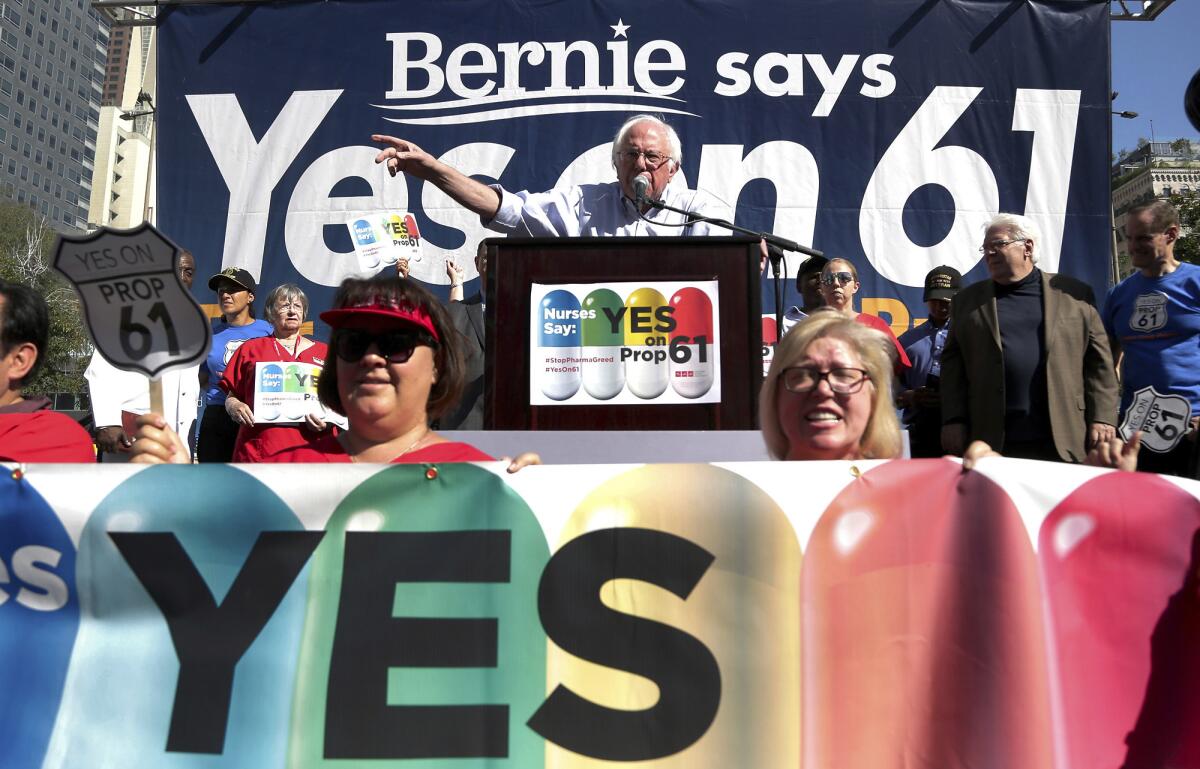Column: Political Road Map: Californians have a long, love-hate relationship with ballot propositions

- Share via
Ballot measures are referred to by some observers as California’s fourth branch of government, a 105-year-old system for citizen approval of laws and constitutional amendments that is baked into the state’s political DNA.
And even though they grumble, voters generally like them. Seventy-nine percent of voters in a USC Dornsife/Los Angeles Times post-election poll said voting on one or more of this fall’s propositions was important to them.
The nonpartisan Public Policy Institute of California has found six in 10 likely voters think they do a better job at enacting laws than do legislators in Sacramento.
Voters were put to the test last week, on issues from legalizing and taxing marijuana to whether actors must use condoms in pornographic movies. If current tallies hold, two-thirds of the 17 propositions will have passed. And while it wasn’t the longest ballot in history (there were 48 propositions in 1914), this year’s were decidedly more complex and required a record-setting 224-page voter information guide.
Support for the system, though, didn’t stop Californians in groups small and large this election season from wondering why their elected representatives couldn’t have handled all of these issues. And here’s the answer: In many cases, proposition proponents never take their issues to the state Capitol.
Of the seven November ballot measures that could’ve been enacted by the Legislature, backers of all but one went straight to the voters. That includes the condoms initiative, Proposition 60, and the effort to limit state government spending on prescription drugs, Proposition 61. Both were championed by a Los Angeles health activist who opted out of the state legislative process. So, too, did backers of marijuana legalization and those who wrote the two initiatives to change the death penalty.
Political Road Map: Election day has become election month in California »
Eight of this fall’s propositions were constitutional amendments and could be made only by voters. But here, too, lawmakers were skipped. Some of the measures, like Proposition 56’s tobacco tax hike, could’ve been drafted as simple state statutes but included constitutional provisions to tightly control the revenues. That was also true of the extension of current income tax rates on the wealthy, Proposition 55.
And when an interest group loses a statehouse fight, it can appeal to voters to overturn that decision through a referendum. Plastic bag manufacturers tried, and failed, to do that with Proposition 67. They then added a political twist, gathering signatures for Proposition 65, that would have swiped new fees on paper bags from grocers. They lost that battle, too.
Support for the initiative process notwithstanding, voters have said some improvements would help, like more disclosure of who funds the campaigns that this year set a new record. Polls also show support for helping citizen groups without big bank accounts get their ideas on the ballot.
One recent change, allowing initiatives to be withdrawn at the eleventh hour if supporters strike a deal with lawmakers, helped stave off a blockbuster battle over raising the statewide minimum wage to $15 an hour. Voters may be skeptical of lawmakers tinkering too much with the initiative process, but few would probably object to changes that speed up finding solutions to California’s biggest challenges.
“Widespread consensus exists for making changes,” a PPIC report on ballot measures in 2013 found. “And reforms are likely to pay large dividends.”
Follow @johnmyers on Twitter, sign up for our daily Essential Politics newsletter and listen to the weekly California Politics Podcast
ALSO:
There are still more than 4 million ballots left to count in California
California’s fall voter guide is a record-setting 224 pages
Updates on California politics
More to Read
Get the L.A. Times Politics newsletter
Deeply reported insights into legislation, politics and policy from Sacramento, Washington and beyond. In your inbox twice per week.
You may occasionally receive promotional content from the Los Angeles Times.











